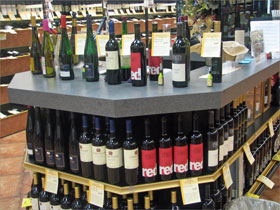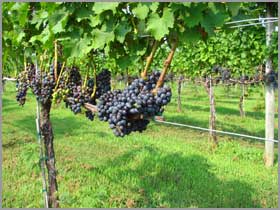 Writing a wine blog, of course, requires drinking wine. Not necessarily in large quantities, but enough to learn more and more about the varieties that different wine-growing regions produce, their distinguishing features, and how to enhance your enjoyment of them.
Writing a wine blog, of course, requires drinking wine. Not necessarily in large quantities, but enough to learn more and more about the varieties that different wine-growing regions produce, their distinguishing features, and how to enhance your enjoyment of them.
Saturdays have now become a school day for me, thanks to the local Total Wine & More shop, part of a group of wine superstores in seven states that boast about 8,000 types of wines on their shelves. I visited the one near me for a public “Tasting Table” to try some of them out.
I’m picturing this as a kind of virtual university, if they keep letting me back. And the best part is there’s no tuition and no pre-enrollment exam. Believe it or not, you merely have to walk through the door to be treated to a half-dozen or more free selections, a refreshing oasis away from the weekend lawn-mowing, shopping, cleaning, etc., even though it’s only a couple small swallows per selection.
Each week features a different theme. This time it was German and Austrian picks, which appeared to be hits with the several customers of various ages who formed a very convivial sort of classroom around the wine table.
My favorite was the Winzer Krems Gruner Veltliner, (2005; $13.99) a highly popular Austrian white with a citrus-laced freshness that’s surprisingly dry if you’re expecting a Riesling kind of response. Makes you think about cooking up a Wiener schnitzel just for the occasion.
As a bonus, not only are the drinks free but so, too, is a 443-page store-branded “Guide to Wine” that helps you dig into the background of the bottles you like.
You learn, for example, that Austrian whites have become the “darlings” of Manhattan’s best restaurants lately, converting loyal Chardonnay drinkers with their bracing elegance and intoxicating finishes.
And then you find this description that seems to have been the notes from a mind-reading session about what you just drank: “Big but never heavy, forceful but not overbearing, they are like drinking liquid crystal.”
The guide helps your appreciation further with a section on Enhancing Your Enjoyment, offering some down-to-earth guidelines to judge a wine through such factors as color, aroma and flavor intensity. And it’s clearly aimed at non-snobs, as illustrated by this tidbit:
“The prevailing myth that one must dedicate his or her life to ardent study of wine prior to being allowed an opinion on matters of taste and evaluation of wines is simply not true. It is not necessary to spend years in a dank cellar, hunched over vintage charts, studying the fermentation process by candlelight while possessing an encyclopedic knowledge of every wine producer in the world in order to participate in a conversation about wine.”
Amen.
Regrettably, the guidebook doesn’t appear to be available on the Total Wine website. (I’d link to it if it were.)
But as the spirit of that book would proclaim, you don’t have to be an expert, or a blogger, for that matter, to take advantage of wine tastings, even if there’s no superstore nearby. Many more-modest wine shops welcome in patrons for samplings.
 During a recent vacation in Chincoteague, VA, that I blogged in a previous article, I dropped by the mom-and-popish Wine Cheese and More shop for a tasting hosted by the Williamsburg Winery (you may be pleasantly greeted with some classical music if you click on the site).
During a recent vacation in Chincoteague, VA, that I blogged in a previous article, I dropped by the mom-and-popish Wine Cheese and More shop for a tasting hosted by the Williamsburg Winery (you may be pleasantly greeted with some classical music if you click on the site).
Four wines were featured there, with my pet being the John Adlum Chardonnay (2005; $13.99). It had a clean, pleasant hint of grapefruit and a feel of French oak in the finish, though I had a hard time sensing the touch of hay that the store’s proprietor detected. Wine Spectator, reviewing the 2004 vintage, gave it an 86 rating and called it, “Clean, with modest toast giving way to fresh apple and melon hints. Nice, crisp finish.”
Check out the usual directories or local newspapers to find a wine shop near you that throws tastings. Or try out my own Google-powered map, designed expressly to help locate neighborhood wine bars and shops anywhere in the country.
My other homegrown tool, what I call All-In-One Wine Search, serves up the latest reports about wine bars and tastings from leading news sites and blogs. You can also type “festival” in the search box, along with your location, to scope out possible wine festivals in your area.
And remember, non-experts are more than welcomed at these things. Hey, this is only my second posting and I already feel like a grad student.

 Virginia’s Eastern Shore may not be the first place that comes to mind when you think about wineries. But it shouldn’t be the last, as I discovered during a recent getaway to Chincoteague and the
Virginia’s Eastern Shore may not be the first place that comes to mind when you think about wineries. But it shouldn’t be the last, as I discovered during a recent getaway to Chincoteague and the  Being a pioneer wasn’t easy. Many of the vines he imported from a California nursery had to be replaced a couple times, he says. His wife, Francesca, became pregnant (Angelica is five now and speaks the most delightful French). It became clear that another source of revenue had to be found. And thus was born the winery plan.
Being a pioneer wasn’t easy. Many of the vines he imported from a California nursery had to be replaced a couple times, he says. His wife, Francesca, became pregnant (Angelica is five now and speaks the most delightful French). It became clear that another source of revenue had to be found. And thus was born the winery plan.